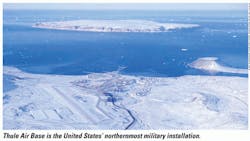Icy Hot: Army-Built Exhaust-Gas Boilers Take Chill off the Arctic
Within the Arctic Circle, among icebergs and glaciers, in a coastal valley in the northwestern corner of Greenland, is a fortress in Thule ("Two Lee") Air Base. Inside, U.S. Air Force men and women have the immense responsibility of tracking foreign military rockets and missiles using large, powerful radars. The moment a threat is detected, they are able to communicate directly with the White House.
Supported by the U.S. Army Corps of Engineers, New York District, the 254-sq-mile base is home to hundreds of active-duty U.S. Air Force personnel and American, Danish, and Greenlandic civilian contractors. Its facilities include dormitories, medical centers, and aircraft runways. Recently, the Army Corps improved the base's heating system by replacing outdated and inefficient boilers with energy-efficient exhaust-gas boilers that will save the U.S. Air Force and taxpayers millions of dollars in fuel costs.
New Energy-Efficient Heating System
The base's heating-system boilers were either no longer operational or operating very inefficiently. Recoverable heat was being lost to the atmosphere; to make up for the loss, a considerable amount of fuel was being consumed. The base's heating system consisted of three structures: the M-Plant, which provided the base's electricity and some steam, and two steam plants, which provided steam for the base's heating and hot water. Each of the buildings used considerable fuel to run engines and boilers.
The Army Corps, with Denmark-based contractor GC/MTHøjgaard, is removing the old boilers and installing four new exhaust-gas boilers in the M-Plant, which will practically consolidate all steam production under one roof. To make room for the boilers, an extension was built onto the M-Plant. The two steam plants will serve as an emergency backup heating source. This consolidation will save the base approximately 1.6 million gal. of fuel annually.
Two of the new boilers were installed during summer 2010. The other two will be installed during summer 2011.
The new boilers are connected to five 12-cylinder diesel engines that drive five large generators, each rated at 3,000 kw. The engines, which run on jet fuel (JP-8), produce an abundance of exhaust fumes at temperatures of 700°F to 840°F.
"The diesel engines that drive these generators are very much like those found in today's vehicles, only much larger and stationary," Robert Philbrick, Air Force team leader, U.S. Army Corps of Engineers, New York District, said. "They convert fuel oil into mechanical energy to turn the electric generators instead of turning vehicle wheels." Exhaust fumes are led to the boilers by exhaust pipe. The fumes enter the boilers' tubes and heat the water surrounding them, converting the water into steam. When it leaves the boilers, the steam is about 330°F. It is piped to all of the base's buildings for heating and hot water.
When the steam reaches a building, it goes into a mechanical room, where it enters a heat exchanger and is used to create hot water. The hot water flows through the building’s radiators and heats the rooms.
According to Stella Marco, project manager, U.S. Army Corps of Engineers, New York District, the new system is expected to save the U.S. Air Force and taxpayers $3 million in energy and fuel costs annually.
Construction Work in an Arctic Environment
In Greenland, construction is limited to the summer and autumn months—May through October. From June through August, temperatures can reach 40°F, and there is 24 hr of sunlight. The remainder of the year is characterized by severe storms and temperatures as low as minus 30°F. From November through February, there is 24 hr of darkness. With Greenland locked in by ice nine months out of the year, shipments of building materials and fuel can be received via cargo only during summer.
In addition to a narrow construction window, workers have other challenges, including a ground foundation comprised completely of ice. Most of northern Greenland is covered with permafrost—permanently frozen ground—ranging from 6 to 1,600 ft in depth. Because of the permafrost, most structures, including the M-Plant extension, have to be elevated 39 in. from the ground.
"If buildings are not constructed off of the ground, the heat from inside the building can melt the permafrost, making the ground unstable and causing buildings to sink," Paul Jalowski, resident engineer, U.S. Army Corps of Engineers, New York District, said.
Buildings are elevated with spread footing that goes down about 10 ft. Concrete columns come up and support the floor system above the ground. In the case of the M-Plant extension, the flooring was insulated to prevent any heat from the building or its equipment from heating the permafrost.
The base's steam- and electrical-piping conduits also need to run aboveground to prevent the permafrost from melting.
Conclusion
Thule Air Base is in the throes of winter storm season, during which temperatures are severe enough to cause frostbite in less than a minute. Thanks to the base’s more efficient heating system, fuel costs no longer will take a bite out of the U.S. Air Force's budget.
JoAnne Castagna, EdD, is a technical writer/editor for the U.S. Army Corps of Engineers, New York District. She can be contacted at [email protected].
Did you find this article useful? Send comments and suggestions to Executive Editor Scott Arnold at [email protected].
